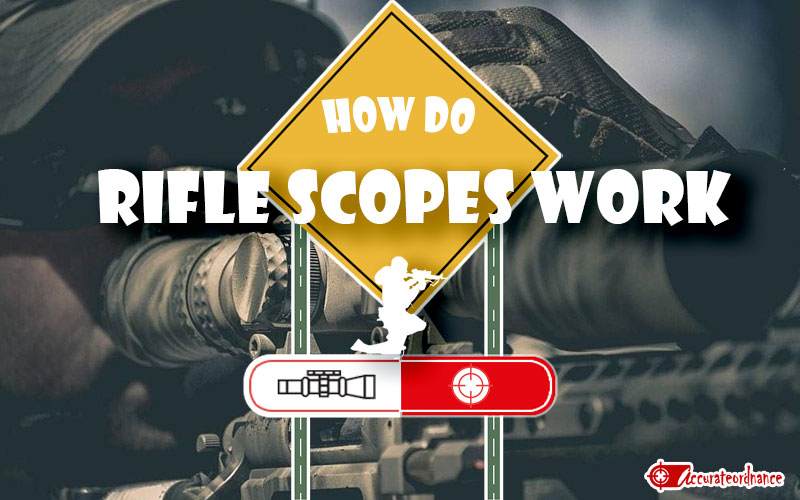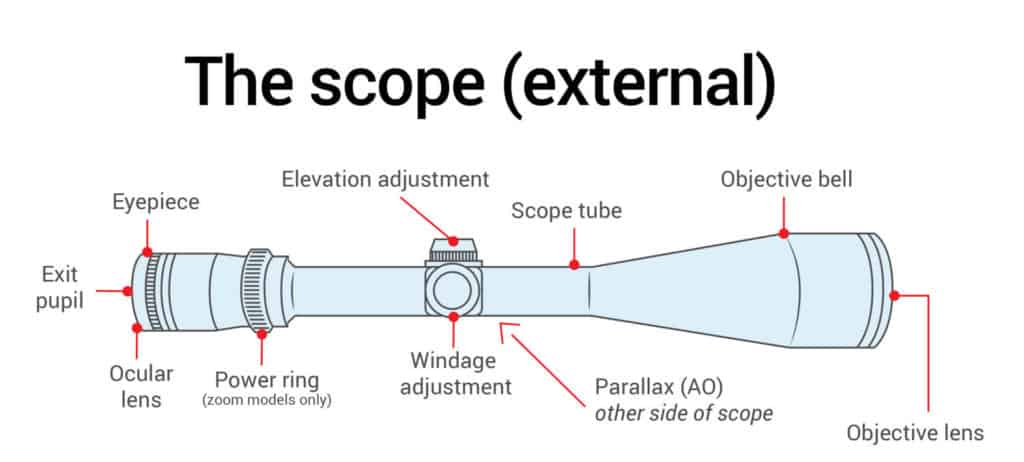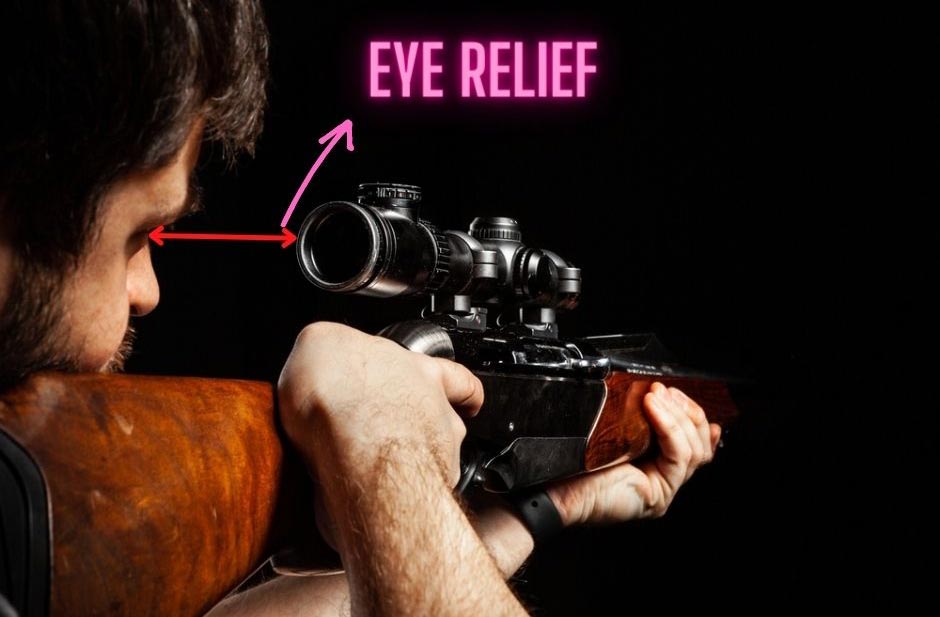A rifle scope is a long range shooting accessory that is mounted onto a rifle and allows the shooter to view targets at a long distance clearly. Rifle scopes are designed in different forms and sizes, but they are always made of the same basic components. Some rifle scope components include the eyepiece, objective lens, and others.

The history of the rifle scope is a little complicated. The earliest firearm aiming tools were made of simple iron sights which could easily hit targets when shooting at a close range. These iron sights cannot help in long range shooting. The rifle scope’s design has changed over time and it now incorporates a variety of components that make operating the accessory easier. You can now aim at targets at longer distances without missing your shots. Rifle scopes are the most valuable tools for competitive shooting and hunting, making a shooter achieve precise and accurate shooting.
Have you ever wanted to know how a rifle scope works? This article is for you, continue reading to find out more!
How Do Rifle Scopes Work?
A rifle scope is a gear that is connected to the top of the rifle and allows a shooter to see further and more clearly. The major components of a scope include a lens, reticle, and mount. The lens is the component of the rifle scope that is responsible for light transmission to the reticle. The reticle is a pattern that aids in firearm aiming.
Types Of Rifle Scopes
There are so many types of rifle scopes and each one comes with its own set of pros and cons. The major types are:
Fixed power scope: This type of rifle scope gives a clear view of the target by using a single scope magnification. They are usually less expensive and also known to have a poorer accuracy compared to the other types of scope.
Variable-power scope: This type of scope make use of two lenses to produce varied magnifications for various ranges. The lens with the higher magnification allows for a good view of closer targets, and the lens with a lower magnification helps in longer ranges. A Variable-power scope is more expensive than a fixed power scope. They are more accurate and also allow for the selection of different scope magnification.
Internal and External Components
In its most basic form, a rifle scope is just a tube that has magnification lenses and a reticle for marking the point of impact of your bullet, in other words, it is a small telescope that has crosshairs. The tubes are often made of high-quality aluminum, usually known as “aircraft aluminum,” although they can also be made with steel and titanium. Aluminum is usually your best choice; titanium is heavier and more expensive, while steel takes more care to avoid corrosion. Let’s find out more about the Internal and External components of a rifle scope.
External Components of a Scope

The external components of a rifle scope perform different functions. They work together to give the scope its full functionality. Here are some external components;
Objective bell
The objective bell is located at the far end of the riflescope and it houses the objective lens of the scope. This part of the riflescope is in charge of light gathering. The diameter of the objective lens determines how much light enters the scope and is delivered to your eye (light transmission).
NOTE:
The objective lens is closer to the object/target while the ocular lens or eyepiece is closer to the eyes.
Scope Tube
The main tube has a lot of external functions. It houses and protects the scope’s internal components, offers the surface area to attach the scope to the rifle through scope rings, and houses the adjustable controls that are used to fine-tune its performance.
Windage and elevation adjustments
Windage and elevation adjustments are located midway through the scope tube. The windage adjustment, which is usually found on the right-hand side of the tube, rotates the reticle to correct the point of impact of the bullet in the left to the right plane.
During the elevation or height adjustment, the upwards and downwards directions of the impact point are corrected. “Clicks” are used to make these adjustments. There are two major click values: milliradian (MRAD) and Minutes of Angle (MOA). At 100 yards, the 0.1 MRAD clicks cause a 0.26-inch change to the point of impact, while the ¼ MOA clicks changes the impact point by ¼ inch.
The adjustment mechanism is made up of a spring, a spindle, and a click element, all of which are calibrated to guarantee that the changes made correspond to desired values.
Parallax Adjustment
Some riflescopes have 3 adjustment knobs, the third one can be used for adjusting parallax. Scopes without a parallax knob may feature an adjustable objective, which is adjusted by spinning the objective bell. These riflescopes are known as adjustable objective (AO) scopes.
At the ocular lens end, there may be an extra diopter adjustment, which focuses the reticle by turning the ocular. People who don’t completely understand how their scope works usually assume they can focus on their target by changing the diopter at the ocular. This adjustment can only be used to ensure optimal reticle focus and not target focus.
Power Ring
The power ring is the last external adjustment. This is a variable power scope feature that allows you to modify the magnification or power of your riflescope. It is positioned near the back of the tube (i.e between the adjustment knobs and the ocular) and is operated by the rotation of the ring. The power ring helps to tune to the magnification setting needed for shooting at that range.
Internal Components of a Scope
On the interior of the scope, the anatomy becomes a little more complicated! The lenses are the soul and heart of your scope. We have the ocular lens, magnification lenses, focus lens, and objective lens. The lenses of most contemporary rifle scopes are coated to prevent glare or reflection. The lesser the light reflected by a lens, the higher the light transmission to the eye. Coated lenses may significantly improve a scope’s light-collecting capabilities, boosting its usability when shooting in low light conditions. Because the objective lens is the primary light-collecting lens, its diameter and coating may make or break your scope in terms of performance in low light conditions.
Objective Lens
An objective lens is that part of a rifle scope that receives and projects light from the object/target onto your eye. It is made of glass or plastic and sits in front of the eyepiece, closer to the exit of the barrel. The objective lens assembly inside the scope tube houses the objective lens. If you have an AO scope, you can adjust for parallax by rotating the AO and adjusting the objective lens position.
Focus Lens
The focus lens is contained in the focus lens assembly of the scope. This lens has the option of being fixed or adjustable. The focus lens of a fixed focus scope is factory configured to be parallax-free at a certain range, typically 100 yards. Rotating the knob on models that have a parallax adjustment knob can adjust for parallax at varied ranges by moving the assembly closer or further away from the objective lens.
Erector Tube
Moving further inside the main tube towards the ocular, we reach the erector tube. The reticle assembly and magnifying lenses are both housed in the erector tube. When the power ring of a variable power scope is tuned, the lenses within the erector tube move closer to the objective lens on high magnification and closer to the ocular lens on low magnification.
Reticle
The reticle is sometimes known as the “crosshairs.” In a riflescope, the reticle cell can be behind or in front of the magnifying lens. A first focal plane reticle is one that has the reticle in front of the lens. A change in the scope’s magnification can make the reticle change size from the shooter’s perspective. In actuality, the size of the reticle with respect to the target remains constant. Because the reticle retains its relative size, an object that is 5 dots tall at low magnification remains 5 dots tall at high magnification, implying that all estimates of the range and elevation remain the same at any magnification setting.
The reticle on a second focal plane reticle is located behind the magnifying lens. The reticle retains its actual size from the shooter’s perspective, but shrinks or expands with respect to the target when the magnification is modified. The disadvantage is that ballistic or range calculations are only valid at a single power level and must be corrected with each magnification adjustment.
There are several reticles available. Some are basic crosshairs, while others have three posts. Some reticles are calibrated by hash or dots markings along the hairs to help with calculations of on-the-fly range, holdover, and windage correction. These are known as MIL-DOT reticles.
We have an illuminated reticle and an unlighted reticle. The illuminated reticle can be green or red. There are no rules to choosing the best rifle scope when it comes to lighting preference.
The erector tube also acts as a connection point between the reticle and the adjusting knobs. The springs and spindles that lead to the knobs meet here, and the erector tube moves as you make adjustments. People are often surprised when they look through the scope while changing the windage or elevation. The reticle appears to be moving in the other way. This occurs because the picture delivered to the erector is really upside down.
Ocular Lens
The ocular assembly is the final destination on the scope tour. This is your scope’s eyepiece. This is also where the diopter is changed allowing individual users to bring the reticle into focus by altering the location of the ocular lens. It is critical to avoid over-adjusting the ocular. The primary objective of this adjustment is to sharpen and focus the reticle; do not use this adjustment to sharpen the target image!
Some Important Optical Properties for Shooters
Let’s talk about some optical properties in a rifle scope.
Power
The first thing to mention is power. A scope’s power is how much a picture is magnified. The image seen through a 4X scope would appear four times bigger than with the naked eye. In a variable power scope, the power is labeled as a range, for example, a 4-12X scope can adjust the image between four times bigger to twelve times larger than naked eyes.
Scopes are usually labeled by objective lens diameter and magnification range, thus a scope labeled 3-12X50 would have a range of magnification of 3 to 12 and an objective lens diameter of 50mm.
Exit pupil diameter
Exit pupil diameter is not measured but calculated, it is the size of the light beam that exits the ocular and enters your eye. The diameter of the exit pupil is calculated by dividing the objective lens diameter by the power of the magnification lens. As an example, a 50mm objective lens that has 5X magnification would have an exit pupil diameter of 10mm.
Eye relief

Eye relief is the distance between the eye and the ocular lens. The most crucial factor to consider when selecting a scope for eye comfort is the recoil of your weapon. A short eye relief might place your eyes in the danger zone if you’re firing a high-powered rifle. Ensure you get a scope with good eye relief to keep you safe. It’s also worth noting that as magnification increases, so does eye relief.
Field of view
The field of view is the area covered by the view in your scope. For example, a FOV of 40′ at 100 yards signifies that your scope image is 40 feet wide at 100 yards. In variable power scopes, this number is expressed as a range, with the field of view shrinking as the magnification increases. When aiming at a moving target, a broad field of view is advantageous because the target would still be within your view.
Parallax and Parallax Error
In a riflescope, parallax is caused when the target and the reticle are not aligned on the same plane. Parallax error is a condition in which the reticle shifts location on the target as the eye is moved, which can obviously skew your accuracy. Some riflescopes have a fixed focal point and are meant to be parallax free at a specific range, which is often 100 yards. Other scopes offer parallax correction adjustments, which may be done using a side focus knob or adjustable objective. Parallax is decreased or eliminated in either situation by altering the relative positions of the focus lens and the objective lens. At low magnifications, parallax is rarely a concern, but it may become an issue at higher magnifications.

Mike Hardesty is a published freelance gun writer. He also possesses specialized expertise in rifle scopes With dozens of articles and reviews published in Pew Pew Tactical, Snipercountry.com, and TTAG (The Truth About Guns), Mike is considered a firearms expert. His special area of expertise is handguns.
Mike is a long-time shooter. He has been punching paper targets, taking deer and other game and shooting at competitions since about 1975. Other related pursuits include reloading and bullet casting. He currently reloads for over 10 calibers, both handgun and rifle. His reloads, particularly for 9mm, were in great demand during the height of the ammo shortage among family and friends. He donated hundreds of rounds to informal shooting sessions. He was quoted as saying “I do not sell my reloads but I sure will help my guys shoot ’em for free!”. He has a few cherished firearms that he has inherited or otherwise procured — those are his favorites.
He earned B.S. and M.S. degrees from Indiana State University in 1974-1975.
He’s a firearm experts and is the founder of mhardesty.com.
